Fawn lily facts for kids
Quick facts for kids Fawn lily |
|
|---|---|
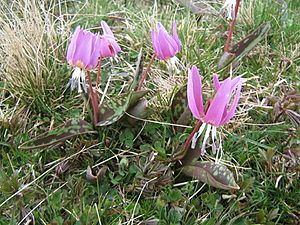 |
|
| Erythronium dens-canis | |
| Scientific classification |
|
| Kingdom: | Plantae |
| Clade: | Tracheophytes |
| Clade: | Angiosperms |
| Clade: | Monocots |
| Order: | Liliales |
| Family: | Liliaceae |
| Subfamily: | Lilioideae |
| Tribe: | Lilieae |
| Genus: | Erythronium L. |
| Type species | |
| Erythronium dens-canis |
|
| Synonyms | |
|
|
Erythronium, also known as the fawn lily, trout lily, dog's-tooth violet, or adder's tongue, is a group of beautiful plants. These plants are found in both Eurasia (Europe and Asia) and North America. They belong to the lily family and are very closely related to tulips.
The name Erythronium comes from an Ancient Greek word, erythros, which means "red". This name was chosen because of the red flowers of one specific type, the E. dens-canis. Most of the known Erythronium species live in North America. Only six types are found in Europe and Asia.
Discover the Many Types of Fawn Lilies
The Erythronium group includes about 20 to 30 different species. These are perennial plants, meaning they live for more than two years. They are also hardy, which means they can survive tough weather conditions. These plants bloom in the spring and have long, tooth-like bulbs underground.
Their slender stems hold flowers that hang downwards. The petals, called tepals, curve backwards. You can find these flowers in many colors, like cream, yellow, pink, and mauve. Erythronium plants naturally grow in forests and meadows in temperate areas of the Northern Hemisphere.
Here are some examples of the different Erythronium species:
| Image | Species | Common name | Where it grows |
|---|---|---|---|
 |
Erythronium albidum | White fawn-lily | Ontario, east-central United States |
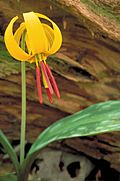 |
Erythronium americanum | Yellow trout-lily | Eastern Canada, Eastern United States |
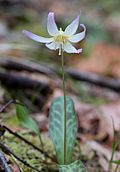 |
Erythronium californicum | California fawn-lily | Northern California |
 |
Erythronium caucasicum | Caucasian dog's tooth violet | Caucasus, Iran |
 |
Erythronium citrinum | Cream fawn-lily | Oregon, Northern California |
 |
Erythronium dens-canis | Dog's-tooth violet | Southern and Central Europe |
| Erythronium elegans | Coast Range fawn-lily | Oregon | |
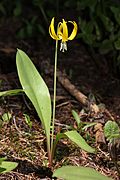 |
Erythronium grandiflorum | Glacier lily | Western Canada, western United States |
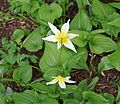 |
Erythronium helenae | Pacific fawn-lily | California |
 |
Erythronium hendersonii | Henderson's fawn-lily | Oregon, Northern California |
| Erythronium howellii | Howell's fawn-lily | Oregon, Northern California | |
| Erythronium idahoense | Idaho fawn-lily | Montana, Idaho, Washington state | |
 |
Erythronium japonicum | Katakuri | Japan, Korea, Russia, China |
 |
Erythronium klamathense | Klamath fawn-lily | Oregon, Northern California |
| Erythronium krylovii | Tuvan trout-lily | Russia | |
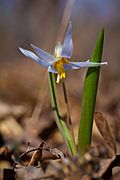 |
Erythronium mesochoreum | Midland fawn-lily | Central United States |
 |
Erythronium montanum | Avalanche lily | BC, Washington state, Oregon |
 |
Erythronium multiscapideum | Sierra fawn-lily | California |
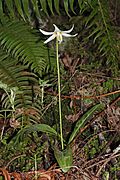 |
Erythronium oregonum | Giant white fawn-lily | BC, Washington, California, Oregon |
| Erythronium pluriflorum | Manyflower fawn-lily | Madera Co in California | |
 |
Erythronium propullans | Dwarf trout-lily | Minnesota |
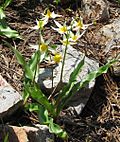 |
Erythronium purpurascens | Purple fawn-lily | California |
 |
Erythronium pusaterii | Kaweah Lakes fawn-lily | Tulare Co in California |
| Erythronium quinaultense | Olympic fawn-lily | Olympic Peninsula in Washington state | |
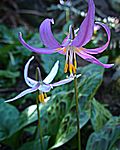 |
Erythronium revolutum | Mahogany fawn-lily | BC, Washington state, Oregon, California |
 |
Erythronium rostratum | Yellow trout-lily | South-central United States |
 |
Erythronium sajanense | Krasnoyarsk in Russia | |
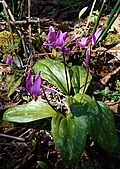 |
Erythronium sibiricum | Siberian fawn-lily | Siberia, Kazakhstan, Xinjiang, Mongolia |
 |
Erythronium sulevii | Altay Krai in Russia | |
 |
Erythronium taylorii | Taylor's fawn-lily | Tuolumne Co California |
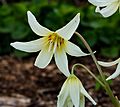 |
Erythronium tuolumnense | Tuolumne fawn-lily | Tuolumne Co in California |
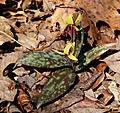 |
Erythronium umbilicatum | Dimpled trout-lily | Southeastern United States |
Growing and Using Fawn Lilies
Erythronium plants are very popular as ornamental plants, which means people grow them for their beauty in gardens. There are many different hybrid types and cultivars (plant varieties created by humans) that have been specially chosen for gardens. Some popular types include Erythronium 'Pagoda', E. 'Sundisc', and E. californicum 'White Beauty'.
The best way to grow new plants is by planting seeds in the autumn. You can also divide the bulbs, which works well for some species. Some types of Erythronium can even spread on their own. These plants are great for covering the ground in a garden, as they will spread out over several years.
Many Erythronium types have won awards, like the Royal Horticultural Society's Award of Garden Merit. Some of these award-winning types include:
- 'Apple Blossom' (white flowers with a yellow center)
- 'Janice' (pink flowers)
- 'Pagoda' (cream yellow flowers)
The bulb of the Erythronium plant can be eaten like a root vegetable. It can be cooked or dried, and even ground into flour. The leaves can also be cooked and eaten as a leaf vegetable. In Japan, the Erythronium japonicum is called katakuri. Its bulb is used to make starch, which is then used in food and for other purposes.
See also
 In Spanish: Erythronium para niños
In Spanish: Erythronium para niños

